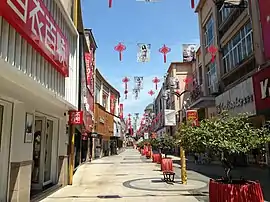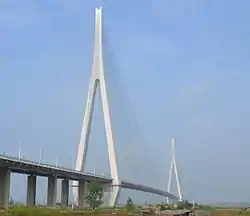Huanggang
Huanggang is a prefecture-level city in easternmost Hubei Province, China. It is situated to the north of the middle reaches of the Yangtze River and is bounded in the north by the Dabie Mountains and is named after Mount Huanggang.[1] It borders Henan in the north, Anhui in the east and Jiangxi in the south.
Huanggang
黄冈市 Hwangkang | |
|---|---|
    Clockwise: Huanggang skyline, Li Siguang Memorial Museum, Shopping street in Huangzhou, Mount Tashan near Fengshan. | |
.png.webp) Location of Huanggang City jurisdiction in Hubei | |
 Huanggang Location of downtown Huanggang in Hubei | |
| Coordinates (Huanggang municipal government): 30°27′13″N 114°52′21″E | |
| Country | People's Republic of China |
| Province | Hubei |
| Municipal seat | Huangzhou District |
| Area | |
| • Prefecture-level city | 17,446.63 km2 (6,736.18 sq mi) |
| • Urban (2017)[2] | 52.22 km2 (20.16 sq mi) |
| • Districts[2] | 362.4 km2 (139.9 sq mi) |
| Population (2010 census[3]) | |
| • Prefecture-level city | 6,162,069 |
| • Urban (2017)[2] | 323,200 |
| • Urban density | 6,200/km2 (16,000/sq mi) |
| • Districts[2] | 426,000 |
| Time zone | UTC+8 (China Standard) |
| ISO 3166 code | CN-HB-11 |
| Local Dialect | Lower Yangtze Mandarin |
| Website | 黄冈市政府门户网站 (Huanggang City Government Web Portal) (in Chinese) |
| Huanggang | |||||||||||
|---|---|---|---|---|---|---|---|---|---|---|---|
| Simplified Chinese | 黄冈 | ||||||||||
| Traditional Chinese | 黃岡 | ||||||||||
| |||||||||||
The city's administrative area covers 17,453 square kilometers (6,739 sq mi) and the total population was 7.4031 million as of the 2017 census, 366,769 of whom resided in the urban area, making it the second most populous city in the province by administrative population, after Wuhan,[4] the provincial capital. The Ezhou – Huanggang built-up (or metro) area was home to 1,035,496 inhabitants comprising (Echeng district and Huangzhou district of Huanggang), and many of its residents work in Wuhan.[4] In 2007, the city is named China's top ten livable cities by Chinese Cities Brand Value Report, which was released at the 2007 Beijing Summit of China Cities Forum.[5]
History

In 845 BC Marquis Wen (文侯) Huang Meng (黃孟; also known as Huang Zhang / 黃璋) moved the capital of the State of Huang from Yicheng to Huangchuan (present-day Huangchuan, Henan). Huang Xi's descendants ruled State of Huang until 648 BC when it was destroyed by the State of Chu. The Marquis of Huang, Marquis Mu (穆侯) Huang Qisheng (黃企生), fled to the state of Qi. The people of Huang were forced to relocate to Chu. They settled in the region of present-day Hubei province, in a region known as the Jiangxia Prefecture (江夏郡) during the Han dynasty (206 BC-AD 220). There are many places in this region today that were named after Huang e.g. Huanggang, Huangpi, Huangmei, Huangshi, Huangan, Huangzhou etc. Many of the people of Huang were also relocated to regions south of the Yangtze River. During the reign of Emperor Cheng of Jin, Later Zhao forces inflicted great damage on many Jin cities and bases north of the Yangtze and captured Zhucheng (邾城, in modern Huanggang, Hubei). Huanggang has a history of at least 2,000 years.[1]
Administration
Huanggang administers 12 county-level divisions, including 1 districts, 2 county-level cities and 7 counties:[6][7][1]
| # | Name | Chinese (S) | ||||
|---|---|---|---|---|---|---|
| Counties | ||||||
| 1 | Hong'an County | 红安县 | ||||
| 2 | Luotian County | 罗田县 | ||||
| 3 | Yingshan County | 英山县 | ||||
| 4 | Xishui County Xi River | 浠水县 | ||||
| 5 | Qichun County | 蕲春县 | ||||
| 6 | Huangmei County Yellow Plum | 黄梅县 | ||||
| 7 | Tuanfeng County | 团风县 | ||||
| County-level cities | ||||||
| 8 | Wuxue City | 武穴市 | ||||
| 9 | Macheng City | 麻城市 | ||||
| District | ||||||
| 10 | Huangzhou District | 黄州区 | ||||
| Other Areas | ||||||
| 11 | Longganhu Administrative District | 龙感湖管理区 | ||||
| 12 | Huanggang Economonic Development Area | 黄冈经济开发区 | ||||
| Map |
|---|
Geography
| Climate data for Huanggang (1981–2010 normals) | |||||||||||||
|---|---|---|---|---|---|---|---|---|---|---|---|---|---|
| Month | Jan | Feb | Mar | Apr | May | Jun | Jul | Aug | Sep | Oct | Nov | Dec | Year |
| Average high °C (°F) | 8.0 (46.4) |
10.6 (51.1) |
15.0 (59.0) |
21.7 (71.1) |
27.0 (80.6) |
29.9 (85.8) |
33.1 (91.6) |
32.8 (91.0) |
28.7 (83.7) |
23.1 (73.6) |
16.8 (62.2) |
10.9 (51.6) |
21.5 (70.6) |
| Daily mean °C (°F) | 4.4 (39.9) |
6.9 (44.4) |
10.9 (51.6) |
17.3 (63.1) |
22.6 (72.7) |
26.0 (78.8) |
29.2 (84.6) |
28.6 (83.5) |
24.4 (75.9) |
18.7 (65.7) |
12.4 (54.3) |
6.7 (44.1) |
17.3 (63.2) |
| Average low °C (°F) | 1.8 (35.2) |
4.1 (39.4) |
7.8 (46.0) |
13.8 (56.8) |
18.9 (66.0) |
22.8 (73.0) |
25.9 (78.6) |
25.3 (77.5) |
21.1 (70.0) |
15.3 (59.5) |
9.1 (48.4) |
3.6 (38.5) |
14.1 (57.4) |
| Average precipitation mm (inches) | 53.6 (2.11) |
72.5 (2.85) |
106.4 (4.19) |
145.7 (5.74) |
166.1 (6.54) |
222.2 (8.75) |
216.6 (8.53) |
143.7 (5.66) |
68.2 (2.69) |
83.2 (3.28) |
60.6 (2.39) |
34.9 (1.37) |
1,373.7 (54.08) |
| Average relative humidity (%) | 79 | 78 | 79 | 78 | 77 | 80 | 79 | 78 | 76 | 76 | 76 | 74 | 78 |
| Source: China Meteorological Administration[8] | |||||||||||||
Cultural heritage
Huanggang is home to several significant cultural sites of historical interest, such as the Buddhist Ancestral Hall of Sakyamuni at Doufang Mountain, Wuzu Temple and its Changchun Nunnery, and Dongpo Red Cliff.
Education
Huanggang Normal University is a full-time institution of higher education located in the city of Huanggang.
Economy
Huanggang has a diversified economy, ranging from bio- and herbal medicine to manufacturing, agriculture, and tourism. Since ancient times, Huanggang has been renowned for local specialties such as the "Qichun Four Treasures" (snake, turtle, bamboo, and moxa), Huangmei "tiaohua" embroidery, and Wuxue "zhangshuiqian" bamboo products. Today, Huanggang at large is recognized for organic vegetables. With its "Guihuaxiang" brand of chestnuts, Luotian is the leading chestnut-growing county in all of China. Yingshan is famous for its "cloud mist" green tea. Qichun, of course, is famous for herbal medicine. Macheng is a national model county for cattle breeding. Huangmei is a major center of freshwater shrimp and fragrant jade rice production. And Hong'an peanut production ranks the first in Hubei Province.
Transportation
Huanggang enjoys an excellent transportation infrastructure. Wuhan airport is 90 kilometers (56 mi) to the west, while Jiujiang Airport in Jiangxi to the east is 160 kilometers (99 mi) away. Being on the Yangtze River, Wuhan main port is located 80 kilometers (50 mi) away, and Huangzhou District has a small bulk-handling port. There is an extensive road network, with three north–south and seven east–west major roads within the main city area. The city also is served by several new expressways, including the north–south "Jingzhu" (Beijing to Zhuhai, Guangdong) expressway and the east–west Wuhan to Shanghai expressway. Huanggang also is on the main north–south "Jingjiu" (Beijing to Hong Kong) and "Jingguang" (Beijing to Guangzhou, Guangdong) railway lines.
Bridges

Two bridges connect Huanggang across the Yangtze to the Ezhou on the south bank of the river:
- Ehuang Bridge, between the main urban area of Huanggang and Ezhou; it carries the China National Highway 106.
- Edong Bridge carries the G45 Daqing–Guangzhou Expressway and the G50 Shanghai–Chongqing Expressway.
Other river crossings near Huanggang include:
- Jiujiang Yangtze River Bridge, between Huangmei County and Jiujiang; a combined road-rail bridge, it carries the Huangxiao Expressway, China National Highway 105, and the Jingjiu Railway
- Huangshi Bridge, which carries the Huanghuang Expressway from Xishui County to Huangshi
Rail
Huanggang is served by the Beijing–Kowloon Railway, which has several stations within the prefecture-level city. The Huangzhou Station, located within Huangzhou District some 20 km (12 mi) northeast from downtown Huanggang, has the best service of all, with several trains a day to Beijing, Nanchang, and Shenzhen.[9] Huanggang travelers can also use the Huangshi station on the Wuhan–Jiujiang Railway, across the river.
Famous people
Huanggang prefecture is the birthplace of numerous famous Chinese inventors, scientists, and scholars, including:
- Bi Sheng, the inventor of movable type printing;
- Cheng Yi, ancient idealist philosopher;
- Dong Biwu, Acting President of the People's Republic of China, 1972–1975;
- Li Shizhen, herbalist and author of the ancient medical classic Compendium of Materia Medica;
- Li Siguang, ethnic Mongol ecologist;
- Lin Biao, one of the ten marshals in China;[10]
- Wen Yiduo, patriotic poet;
- Xiong Shili, a 20th-century Chinese philosopher;
- Daman Hongren, the 5th Chán (Buddhist) Patriarch in the traditional lineage of Chinese Chan;
- Xu Fuguan, a Chinese historian and philosopher, notable for Confucian studies;
- Hu Feng, a Chinese writer and literary and art theorist;
- Chu Bong-Foo, the inventor of the Cangjie method, the most widely available Chinese input method, and the father of the modern Chinese computing;
- Huang Kan, a Chinese philologist.
As well, Huanggang is famous for producing military and political leaders. Hong'an County is known as the "County of Generals" in that more than 400 Chinese army generals have been born there, a total far greater than for any other county in all of China. In addition, former military leader and President of China, Li Xiannian (1909–1992), was born in Hong'an. The family of Taiwanese author Kuo Cheng came from Huanggang.[11]
References
Citations
- 辭海第六版 [Cihai (Sixth Edition)]. Shanghai: Shanghai Lexicographical Publishing House. September 2009. p. 957. ISBN 9787532628599.
- Ministry of Housing and Urban-Rural Development, ed. (2019). China Urban Construction Statistical Yearbook 2017. Beijing: China Statistics Press. p. 66. Retrieved 11 January 2020.
- "China: Húbĕi (Prefectures, Cities, Districts and Counties) - Population Statistics, Charts and Map".
- 湖北黄冈9个县市确诊病例全部“清零”. Xinhua. 2020-03-14. Retrieved 2020-03-21.
- "China's Top 10 Most Livable Cities". hnloudi.gov.cn. Hunan Loudi Official Government. 2012-03-28. Archived from the original on 2013-04-10. Retrieved 2014-08-04.
- 黄冈概况 (in Chinese). Huanggang People's Government. 19 August 2017. Retrieved 4 January 2018.
现辖七县(红安、罗田、英山、浠水、蕲春、黄梅、团风)、二市(武穴、麻城),黄州区、龙感湖管理区和黄冈经济开发区,{...}
- 黄冈市历史沿革 [Historical Development of Huanggang City] (in Chinese). XZQH.org. 15 August 2014. Retrieved 4 January 2018.
2010年第六次人口普查,黄冈市常住总人口6162069人,其中:黄州区366769人,团风县338609人,红安县602148人,罗田县544650人,英山县357296人,浠水县872649人,蕲春县727805人,黄梅县858806人,麻城市849090人,武穴市644247人。
- 中国气象数据网 - WeatherBk Data (in Chinese). China Meteorological Administration. Retrieved 2020-04-15.
- 黄州列车时刻表 [Huangzhou Station Schedule]., as compared to that for the neighboring stations: 浠水,蕲春,武穴
- Lin 164
- 郭箏 (in Chinese). National Museum of Taiwan Literature. Retrieved 22 October 2019.
籍貫: 湖北黃岡
Bibliography
- Lin Biao. "Lin Piao: Master Strategist". In Snow, Helen Foster (Ed.). The Chinese Communists: Sketches and Autobiographies of the Old Guard. Westport, Connecticut: Greenwoods Publishing Company. 1972. ISBN 0-8371-6321-8
External links
| Wikimedia Commons has media related to Huanggang, Hubei. |
| Look up Huanggang or Huang-kang in Wiktionary, the free dictionary. |
